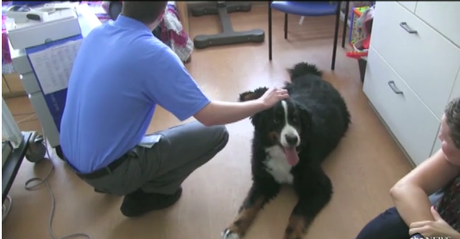 Madison Fleaks had been in Texas Children’s Hospital in Houston for over six months waiting for a heart transplant. She was born with a congenital heart condition.
Madison Fleaks had been in Texas Children’s Hospital in Houston for over six months waiting for a heart transplant. She was born with a congenital heart condition.
Not yet two years old, she may have forgotten much of her life at home. But she still remembered her two dogs; their photograph sat framed next to her hospital bed.
“If you said anything about the dogs, she would point and want to kiss the picture,” said her mother, Tabitha Fleaks. Madison has been in and out of hospitals, she said, enduring multiple surgeries.
“She has been sick her whole life. All she knows is me, her dad, and the two dogs.”
So when her dog Kodiak showed up in her hospital room one day, Madison was thrilled.
“It was amazing,” Fleaks said. “She just lit up. She literally screamed when he walked into the door.”
Texas Children’s is not the only institution to allow some patients to have visitors of the canine variety. ABC News reached out to hospitals around the country and found that many have pet therapy programs, in which a trained owner-volunteer will bring a dog to the hospital for patients to enjoy. These programs have been said to help patients with their mood, pain, and comfort levels.
A growing number of these hospitals have taken their pet therapy programs even farther, allowing patients to have visits from their own pets.
“When there is a patient in the hospital that will be here for a significant amount of time, we think it is important for them to have their entire family here,” said Jamie Snow, Assistant Director of Child Life and Social Work at Texas Children’s Hospital. “And some people consider their pets family members.”
The program started at Texas Children’s four years ago, when administrators were approached by an organization called PAWS (Pets Are Wonderful Support) Houston, a non-profit organization the helps to sustain the relationships between pet owners and their pets during a prolonged hospitalization.
Here’s how it works: a social worker or child life specialist, hearing that a patient has a pet at home, speaks to doctors who can approve a visit. Then PAWS is contacted. They ensure that the pet is vaccinated and has a bath before the visit. A PAWS volunteer will meet the pet and family members at the entrance of the hospital where they perform a “behavior check” to make sure the pet’s temperament is good for a hospital environment. They then take the pet to the patient’s room.
“We have never had any bad events from an animal visit,” said Tricia Lewis, a nursing director at the Methodist Hospital System in Houston, Texas, who worked with PAWS to pioneer the personal pet visitation policy at her hospital over a decade ago. “No bites, no infections.”
Dog Visits Safe if Precautions Taken
Dr. Loreen Herwaldt, a professor of medicine at the University of Iowa Colleges of Medicine and Public Health, and Jean Pottinger, an infection prevention expert for University of Iowa Healthcare, helped bring the personal pet policy to their hospitals. Pottinger, too, said there have never been any infections that were attributable to animals at her hospital. And she said there has been no documentation of any bad outcomes from pet visits in her hospital.
Herwaldt said there is likely good reason for the lack of infections from the animals. “[The patients] were living in very close contact with these animals before they came in and have been exposed to the organisms the animal is carrying,” she said. “They will be going back to that environment as well. We make sure [the patients] wash their hands before and after the visit.”
Hospitals take other precautions to reduce any risk of infection. Barriers are placed between animals and bedsheets, and the sheets are changed after the animal leaves.
The experience has been positive for patients, said Donna Dishman, co-founder and executive director of PAWS Houston. She said the first personal pet visit was remarkable. The patient was an 83-year-old woman in intensive care, diagnosed with breast cancer.
“[She] was not eating, not responding, and had given up,” Dishman said. “When we put her dog on her bed, she started talking, and started eating.”
“Often there are people who are not doing well, and don’t respond to staff and people but for some reason make an effort to speak when animals come around,” said Dr. Lisa Portnoy, a veterinarian and animal program director for the NIH Clinical Center.
Such programs may become even more common as hospitals strive to find special ways to meet the needs of patients and their families.
“I think that when we think about a patient-centered environment, we have to think about what is meaningful to health and well-being to the patient,” said Linda Laskowski Jones, Christiana Care Health System’s Vice President of Emergency and Trauma Services in Delaware, where a personal pet visitation policy is also in place. “The framework has to include animals. That is important to health and recovery and comfort.”
For Tabitha Fleaks, having their family dog visit was comforting to her as well as to her daughter.
“I’m here every single day [with my daughter] and my dogs are a part of our family,” she said. “It made my day to see our dog because I’m so used to seeing them all day long in my house and it made it feel more like home.”
Madison, who had a heart transplant a few weeks ago, will be discharged from the hospital this week.
“Every day when you say, ‘Where is Kodiak? Where did he go? Where is he?’ she points to the door. It was the biggest blessing for her to see him,” Fleaks said.
